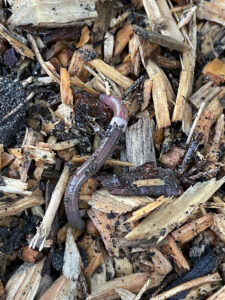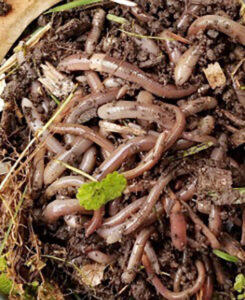By Cathy DeDe, Chronicle Managing Editor
A few months ago, Warren County Cornell Cooperative Extension put out an alert of yet another invasive species — something called Amynthas-Metaphire, commonly known as the Jumping Worm or Asian Jumping Worm.

You know, something seemed familiar about the description they provided. Something had seemed “off” about our worms recently. They were super-squirmy.
Sure enough, some time later, now armed with the Cooperative Extension article — I realized these jumping worms have creeped up in my own backyard, right here in the City of of Glens Falls.
“Creep” is the word.
As a gardener, I have no problem with regular earthworms. They’re a sign of good humus-rich soil, they aerate as they burrow through the ground, and their waste, called “castings,” adds nutrients back in as they go.
Worms = good.
These jumping worms — poke or touch one by accident and it wiggles wildly, somehow threateningly. It’s clear how they got the name. Speaking as a woman who’s usually happy to have her hands in the dirt, it’s gross.
They are also identifiable for the distinctive milky white band that fully encircles the body up near the head.
How they threaten the soil, I’ve learned, is even more disturbing.
“Asian jumping worms devour organic matter more rapidly than their European counterparts, stripping the forest of the layer critical for seedlings and wildflowers,” said the report from the Cooperative Extension.
Compared to “regular” earthworms, they “grow twice as fast, reproduce more quickly, and can infest soils at high densities.”
Chris Dittus at the Cooperative Extension put me in touch with Kristopher Williams, Capital Region PRISM Coordinator — Partnership for Regional Invasive Species Management.
PRISM is “a not for profit quasi-government” entity, he said, that is subcontracted by the state Department of Environmental Conservation to follow invasive species in 11 counties, including Warren-Washington-Saratoga. His offices are hosted at the Saratoga County Cornell Cooperative Extension in Ballston Spa.
“They’re all over the Capital Region,” Mr. Williams said of jumping worms. “I have them in my yard, and I live by Moreau State Park. They’re in the park, too.”
He said they stay in the very top layer of the soil, eat through it voraciously, leaving behind castings that look like wet coffee grounds or hamburger.
More: “They change the soil from a fungal based makeup to bacterial based. Some plants struggle in that kind of soil matrix.”
The website Soil.com says fungi and bacteria are both decomposers in soil. “Fungi are generally much more efficient at assimilating and storing nutrients than bacteria,” the site says, though both are part of a healthy soil makeup.
The jumping worms can change the soil structure to the point that it doesn’t support root systems, Mr. Williams said.
“They are kind of aggressive. They change the soil composition, and that can be problematic for flowers and herbs and shrubs and the forest. They’re voracious eaters. They cycle through the soil matrix so fast, the waste sits on top and it is easily washed away by rainstorms, sometimes leaving tree roots exposed.”
“You see trees and shrubs with exposed roots, and then they don’t have the structure and stability to stand up.
“Is it terrible? It is.”
He says, “We are seeing forests already impacted by deer browse, grazing, together with this. It can be really devastating. There’s no tree seedlings or regeneration.”
How do the worms get here?
“It’s human based,” Mr. Williams says. “We’re purchasing things from overseas, potted plants and nursery stock, bagged mulch and soil.”
“At this time, there is no management system for the jumping worms,” Mr. Williams says. There’s no EPA-approved insecticide, pesticide or vermicide and no natural predator, he said.
Some clues to combatting them: The worms don’t survive a cold winter but the eggs, which are too tiny to discern, will, Mr. Williams says. However, extreme heat will destroy the eggs as well as the worms — if the soil gets to above 140 degrees.
“Prevention is the best thing,” Mr. Williams says. Purchase local plants and garden products from local providers. If buying potted plant stock, he recommends to rinse away and dispose of the soil it came in before you plant.
‘Solarize’ ’em
If you find the worms in your yard?
One option is to “solarize” them, Mr. Williams said.
Literally, he means: Pick them out, put them in a plastic bag and lay them out to bake in the sun, until they are, well, done.
If you suspect an infestation, you can try to draw them out: Mix mustard powder from the kitchen spice cabinet with water and pour it over the soil. The worms don’t like the mustard. It will drive them to the surface and you can “pick them off” by hand, he says — to, you know, “solarize.”
Mr. Williams listed a bunch of other techniques people have tried — some folksy, some frankly comical or potentially scary. None are legal for him even to suggest out loud because they are untested, he says. Research into soap-based vermicides that impact the worms’ mucus shows some promise, he offers.
“They’ve been on the Pacific West Coast for 20 years,” Mr. Williams says. “They’re relatively new here, so we haven’t seen much damage yet. They’re coming on nursery stock and mulch. The best thing is, don’t let it on the property in the first place.”
“Learn the signs and symptoms,” he says. “Use the mustard drench to try and kill them. Inspect your mulch and soil, and keep records of the sources. Reduce yard waste like leaf piles or flower cuttings — don’t provide a food source for them.”
Dig up infested soil, he says, tie it up in a black plastic bag, laid out in a thin layer on your driveway, and leave it to bake in the sun.
Even, Mr. Williams says, keep an eye on your own compost pile. Home composting is good, he says, unless it becomes a home to these invasives. What then? “Remove it.”
“There’s not much help out there yet,” Mr. Williams says.
Cornell University’s New York Invasive Species Research Institute has a JWORM Working Group. It stands for “Jumping Worm Outreach, Research & Management.”
Find more info at www.nyisri.org/research/jworm-2/.
Warren County Cornell Cooperative Extension has an informative article by Master Gardener Sandy Vanno. See www.warren.cce.cornell.edu/ and search “Jumping Worm.”
By the bye, Mr. Williams adds that the common “European” earthworm I’ve always taken as a sign of a healthy soil is itself an invasive species in America — though also clearly well integrated into our ecosystem.
There are about 20 species of worms native to New York, Mr. Williams says. But those are rare, and mostly only found in small out-of-the way pockets of swamp and wilderness, Mr. Williams said.
DEC advice: Invasive Jumping Worms
“Attention, fall gardeners!” begins a press release this week from the New York State Department of Environmental Conservation.
“While earthworms are usually a welcome sight in your garden, not all earthworms are alike. Jumping worms, sometimes known as ‘crazy worms,’ are an invasive species native to Asia that are being found increasingly in many parts of New York State.
“Jumping worms primarily stay in the top layer of soil, leaching nutrients and turning topsoil into a texture similar to coffee grounds. This makes it difficult for many plants to grow, including garden plants, trees, and lawns.
“You can tell the difference between a jumping worm and a less destructive European earthworm by examining the worm’s collar (clitellum). Jumping worms have a collar that is milky-white, relatively close to the head and flush with their bodies.
“Here’s how you can help prevent the spread of jumping worms:
• Know the signs: Look for dark soil that looks like coffee grounds. Jumping worms have a milky-white smooth collar, close to their heads.
• Play. Clean. Go: Check your soil, compost, tools, boots, and plant roots. Clean everything of worms and egg casings before transporting.
• Be worm-wise: When purchasing soil, compost, plants (even trees) or worms for bait, check for jumping worms or egg casings to prevent jumping worms from invading your yard.
• Report: If you find a jumping worm, take a picture and report the sighting to www.nyimapinvasives.org.
Check out the Homeowner’s Guide for Asian Jumping Worms from the NY Invasive Species Research Institute for more information.
Need help identifying a worm, insect, or plant disease? Email a photo and description to DEC at foresthealth@dec.ny.gov.
Copyright © 2021 Lone Oak Publishing Co., Inc. All Rights Reserved
 Glens Falls Chronicle Serving the Glens Falls/Lake George region; Warren, Washington and northern Saratoga counties since 1980
Glens Falls Chronicle Serving the Glens Falls/Lake George region; Warren, Washington and northern Saratoga counties since 1980



